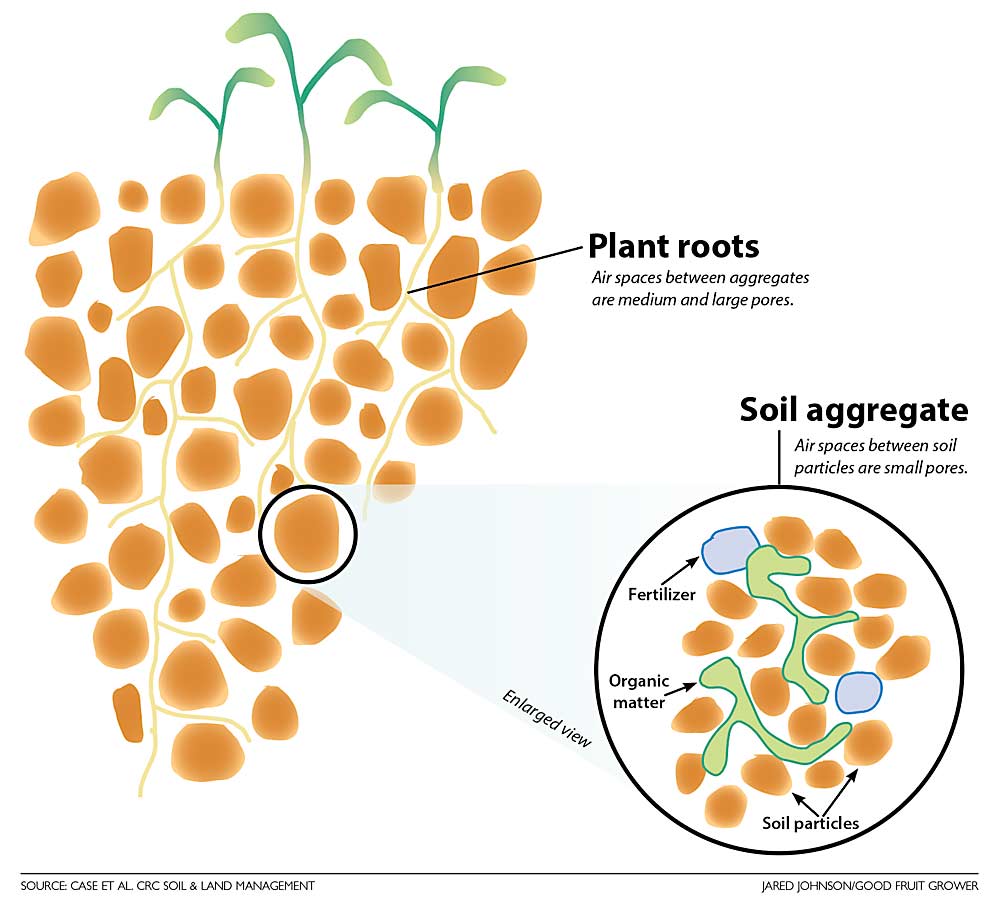
What is a good soil structure?
Soils are not homogeneous but consist of sand, silt and clay held together by inorganic and organic matter into aggregates of different sizes. The arrangement of these aggregates of different sizes, and the pores (spaces) between the aggregates, is termed soil structure. Soil structure affects the growth and distribution of tree roots and their ability to take up water and nutrients, as well as remove toxic gases from the soil, such as carbon dioxide and methane.
A good structure for tree growth contains many aggregates of different sizes, ranging from less than 2 microns to more than 250 microns in diameter, and a network of interconnecting pores that are well drained. This helps growth of roots and movement of water and air through the soil that is sticking to the roots. One micron is 1/1000 of a millimeter, or 0.001 mm.
This article deals specifically with formation and maintenance of aggregates as part of maintaining a good soil structure and good root health in loam and clay soils.
The formation of aggregates
When you carefully pull up a grass or a weed, much soil remains stuck to the roots. The building of a good soil structure is very much centered in soil that sticks to the roots. This is called the rhizosphere. It is often only a few millimeters thick and consists of aggregates of different sizes, called micro- and macroaggregates.
The roots grow through the soil from the tips only. As each root tip grows, it exudes a sticky gel that lubricates the tip to help the roots grow through the soil. The gel contains polysaccharides that act as gums. Polysaccharides are complex carbohydrates, such as sugars and cellulose. When the gel dries, it shrivels and sticks soil particles to the roots and fungal hyphae.
The sticky root tip picks up very small pieces of soil and collects them into an aggregate, until the aggregate becomes sufficiently large that it is detached from the root tip and is left in the soil.
Behind the root tip is a section of root with root hairs, which are long and thin. Root hairs grow from the surface of the roots and are visible to the naked eye. These root hairs and fine secondary roots support fungi that grow thread-like hyphae that branch and extend the root system. Some fungi (saprophytic) grow in the soil only, whereas other fungi (mycorrhizal) grow inside the roots and in the soil. The saprophytic fungi decompose organic matter in the soil, whereas the mycorrhizal fungi extend the root system.
Eventually, roots and hyphae die and are replaced by new ones. The cellulose fibers from which the roots and hyphae are made remain strong and glued into the soil. Gradually, a network of cables and girders (roots and hyphae) develop into macroaggregates, giving them strength and persistence and leaving an aggregate that is rounded and porous. Thus, the grass and weed roots slowly change a newly prepared soil in an orchard into the crumb structure that is necessary for healthy root growth. With grasses and weeds, what grows below ground is more important than what grows above the ground.
The importance of different aggregate sizes, and of the pores between aggregates
A good soil structure for tree growth depends on the presence of micro- and macroaggregates of different sizes, as well as a good range of soil pore sizes between these aggregates.
The large pores between the aggregates allow water and air to move into the soil from above and allow excess water to drain down from the root-zone.
The medium pores allow water to move quickly toward the roots.
The small pores store water for tree growth.
Pores also retain water, fertilizer and organic matter essential for tree growth.
How aggregates of different sizes form and are held together by organic matter
Molecules of soil organic matter (from bacterial and fungal digestion) combine with calcium (from lime and gypsum) to bond clay particles (which are less than 2 microns in diameter) and other particles to form microaggregates.
The biology that makes aggregates stable
Roots can be as fine as 0.03 mm in diameter, and there may be as much as 30 cm of root length per cubic cm of soil. Grasses produce the most roots, and ryegrass has one of the highest root concentrations. Fungi grow within the roots of certain plants, such as ryegrass, and extend the roots.
The length of fungal hyphae in soil is very large — for example, beneath a fruit tree spaced at 4- by 1-meter, the soil could contain about 53,000 kilometers of hyphae. There are also many bacteria and other microscopic organisms. A range of small animals are also important in the soil, with the largest being earthworms.
Many of these biological agents break down plant fragments into smaller and smaller pieces, and eventually to molecules. It is from this process that the aggregates obtain the gums, girders and other compounds that make the aggregates stable.
In soil with high concentrations of organic matter (4 percent or more), this process is strong. High concentrations of organic matter also provide food for earthworms and other animals that mix the soil constituents. The high concentrations of organic matter also provide many organic materials that keep the soil open just by their physical presence. •
—by Judy Tisdall and Bas van den Ende
Judy Tisdall and Bas van den Ende were researchers at the Tatura Research Institute, in the state of Victoria, Australia.






Leave A Comment